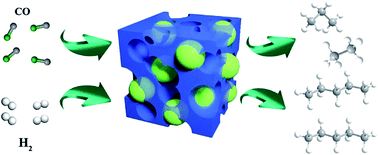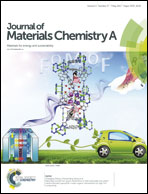Highly dispersed Co-based Fischer–Tropsch synthesis catalysts from metal–organic frameworks†
Abstract
The influence of pore texture and nitrogen species of the carbon support for the Fischer–Tropsch synthesis was investigated using well-defined catalysts derived from metal–organic frameworks (MOFs). Two typical MOFs were employed in the carbonization process to prepare the target catalysts, i.e. nitrogen-rich ZIF-67 and nitrogen-free Co-MOF-74. The Co-MOF-74-derived nanocomposite (Co@C) showed a carbon monoxide (CO) conversion of 30%, whereas the ZIF-67-derived nanocomposite (Co@NC) exhibited a CO conversion of 10%. The nitrogen-free Co@C composite showed 65% selectivity for long-chain hydrocarbons (C5+) and 10% selectivity for short-chain hydrocarbons (C2–C4) after 100 h on stream; on the other hand, the Co@NC composite showed 31% selectivity for C5+ products and 37% selectivity for short-chain hydrocarbons (C2–C4) after 100 h on stream. The excellent CO conversion was attributed to the large pore size of the carbon support, which facilitates the diffusion of the hydrocarbons. The high C2–C4 selectivity originates from the influence of nitrogen species in the carbon support. This study is expected to open a new avenue for the design of new catalysts for the Fischer–Tropsch synthesis with high activity and superior selectivity via choosing suitable MOFs precursors.



 Please wait while we load your content...
Please wait while we load your content...